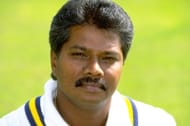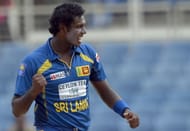Ethnicity has always been a point of discussion in cricket. Whether it be England’s strategy of surrogate citizenship or blacks playing for South Africa or even the recent hue and cry regarding Parvez Rasool becoming the first player from Kashmir to play for India, the “odd one out” is more often than not a talking point.
Which is why it is surprising that no one has gone into an in-depth discussion regarding the Tamils to have played cricket for Sri Lanka given the violent civil war that raged in the country for two decades and, from time to time, even affected the game of cricket on the island.
There is no doubt who the most famous name on that list is but, apart from that, there are a few others who have impacted the way the game has been played in the country over the years.
Mahadevan Sathasivam
Ryan ten Doeschate may disagree but those who have seen “Satha” play say he was the best batsman not to have played Test matches. His fan following include the likes of Sir Garry Sobers and Frank Worrell who even subscribe to the view that he might have been the greatest batsman ever. Satha played for over two decades from the 40s to well into the 60s and, in the process, he became the first and, till date, only man to captain three national teams – Ceylon, Singapore and Malaysia. An accusation of murder marred his off-the-field reputation but nobody could discount his talent on it.
Sabapathy Ilangaratnam
One of a select band of Sri Lankan cricketers to be born in Jaffna, Saba Ilangaratnam was a stalwart for Moratuwa and Bloomfield before the Test match era began for Sri Lanka. Ilange, as he was popularly known, was a fast bowler although his demeanour hardly suggested so. He rarely bowled bouncers as there were no helmets back then and he felt that a yorker or any other delivery would be more effective in dismissing the batsman. He played most of his cricket under Sri Lanka’s first Test captain Bandula Warnapura and was good enough to make it to the team for an unofficial ODI against the visiting MCC team in 1977 and also against Keith Fletcher’s England team in the early 80s although he didn’t get a chance to play the second time around.
Sridharan Jeganathan
Jeganathan holds the dubious claim of being the first Sri Lankan Test cricketer to die but sadly enough his Test career does not have much else to talk about. A left arm spinner who could bat a bit in the lower order, Jeganathan was drafted in from the 1983 New Zealand tour where he managed a highest score of 8 and went wicket less in the two Tests he played. He made a comeback to the squad in the 1987 Reliance World Cup but, after a few insipid performances, dropped out from the international arena. He was a notable figure on the domestic circuit though and later went on to coach Malaysia.
Roy Dias
One of the more famous names on this list, Dias had an inauspicious Test debut against England as he fell to Bob Willis without scoring. He turned that around with a stroke-filled 77 in the second innings and, from that point onwards, became the cornerstone of the Sri Lankan middle order along with Duleep Mendis. He highlighted his class further on Sri Lanka’s tour of Pakistan with a doughty 109 – his highest Test score – at Lahore as the rest of the top order capsized against Imran Khan and mates. He would also star in Sri Lanka’s maiden Test and series win with two match winning fifties and a match saving 106 against India at home. Dias was also a useful off-spinner and all of his three international wickets came in a World Series game against Australia. After his retirement, Dias coached Sri Lanka for some time followed by Nepal and Oman.
Vinothen John
John made his Test debut in the same match as Jeganathan but, unlike the latter, had a relatively more successful career. His Test career as a bustling medium-pacer was limited to 6 matches but he took 28 wickets including two five wicket hauls against New Zealand. Like Jeganathan, John made a comeback in ODIs during the ’87 World Cup and similarly faded into oblivion after taking only one wicket in five outings.
Mario Villavarayan
A talented fast-medium bowler, Villavarayan remained on the fringes of national selection and as a consistent member of the A team for the greater part of his career. He was picked in the squad to tour England in 1998 although he never got a chance to play. He did play for Sri Lanka in the Commonwealth Games that year which were not recognised officially. He retired prematurely at the age of 31 to obtain a degree in Exercise Science and now is in charge of training the Sri Lankan national, A and Development squads.
Russel Arnold
Although the nickname Rusty is commonly associated with the first name Russel, for Arnold it signified the way he batted – not necessarily pretty but tough and pretty. An average of 28.01 after 44 Tests over a span of seven years suggests that Arnold found the going difficult in Test cricket but in limited overs cricket he was the Sri Lankan equivalent of Shivnarine Chanderpaul. Arnold shared most of the qualities which others of his ilk like Michael Bevan have – a calm and cool composition and a high degree of unselfishness. Apart from dragging Sri Lanka out of many unsavoury situations especially while batting second, Arnold was good enough to take more than 50 international wickets and had a safe pair of hands. A like-for-like replacement in Tillekaratne Dilshan shaved off a couple of years from his international career which ended with the 2007 World Cup in the Caribbean. Nowadays he is a popular television commentator and the brain behind the successful “Ask Rusty” iPhone app.
Pradeep Jayaprakashdaran
One of the rare international cricketers whose surname is probably longer than their career, medium pacer Jayaprakashdaran played a solitary match against India in the 2005 Indian Oil Cup at Dambulla. He bowled six tidy overs for 21 taking the wicket of Virender Sehwag in the process but that was apparently not enough to grant him a second try. At 29, a second coming is not ruled out but it seems bleak considering the fact that he has played a single first class match since 16th March 2012.
Sri Lanka’s current and youngest Test captain at 25, Mathews was groomed for the honour for quite some time back. With his robust batting, nagging accuracy with the ball and athletic fielding, Mathews is the all-rounder Sri Lanka have been searching for a long time. So much so that his unavailability for the World Cup final forced three changes in the squad. Like Arnold, Mathews is solid at number 6 in ODIs having played a couple of match-winning knocks from that position. A single Test match century does not suggest much about his batting prowess in Tests but an average of over 40 suggests potential. The Sri Lankan selectors see Mathews as the fulcrum for the future national squads.
What do you write about a man who is the highest wicket taker in Tests and ODIs and has divided the world into two halves with his bowling arm? Call him a chucker, call him controversial but there is no denying that Muttiah Muralitharan is the biggest thing to happen to Sri Lankan cricket ever. Talking about Murali would take an entire article by itself – for now one can appreciate his wizardry by taking a look at this.
Pradeep Mathew
The greatest cricketer ever. At least the greatest cricketer not to given his fair share of dues. To know why I say so, you should read this.
Looking for fast live cricket scores? Download CricRocket and get fast score updates, top-notch commentary in-depth match stats & much more! 🚀☄️



